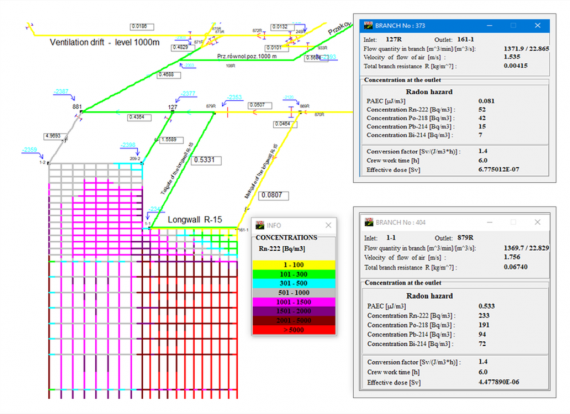Program VentGraph-Radon służy do symulacji emisji, transportu, rozpadu oraz wytrącania się radonu i jego pochodnych w kopalnianych systemach wentylacyjnych. Został opracowany przy współpracy z Głównym Instytutem Górnictwa w ramach unijnego projektu „Merida”.
Materiały skalne, w szczególności węgiel mogą emitować radon. Wtedy w ich otoczeniu powstają radioaktywne produkty jego rozpadu. Przy odpowiednio dużych stężeniach i czasie ekspozycji stanowią zagrożenie dla zdrowia. Radon pojawia się nie tylko w budynkach, ale też w wyrobiskach kopalń. Gaz i produkty jego rozpadu są transportowane z powietrzem wentylacyjnym poprzez wyrobiska kopalń i drogami migracji gazów przez warstwy geologiczne do atmosfery.
Przykład: prezentacja symulacji wyników obliczeń stężenia radonu i energii potencjalnej alfa krótkożyciowych produktów rozpadu radonu Cα w złożonych sieciach wyrobisk kopalni, w rejonie ściany R-15 w pokładzie 713 w likwidowanej kopalni „Anna”. Stan atmosfery w wyrobiskach i zrobach wynikał ze zmierzonego dopływu powietrza w ilości 1361 m3/min i wartości dopływu metanu. Przyjęto rozłożone źródło ekshalacji radonu do każdego wyrobiska na poziomie 0,0185 Bq/(m2*s), przy czym wybrano kilka wyrobisk, gdzie arbitralnie zwiększono poziom ekshalacji radonu w zakresie od 0,55 do 1,8 Bq/(m2*s). W oknach programu można zaobserwować parametry charakteryzujące stany w wybranych bocznicach: stężenia energii potencjalnej alfa oraz stężenie radonu Rn i jego pochodnych: RnA 218Po, RnB 214Pb i RnC 214Bi dla wyrobisk doprowadzającego i odprowadzającego powietrze ze ściany R-15.

INFORMACJA: prof. dr hab. inż. Wacław Dziurzyński